Luxor, Egypt
Sightseeing
Tuesday, January 1, 2008
Happy New Year, everyone! Julia and I went to bed early last night, skipping the New
Year's celebrations as we had a 5:00 a.m. trip this morning.
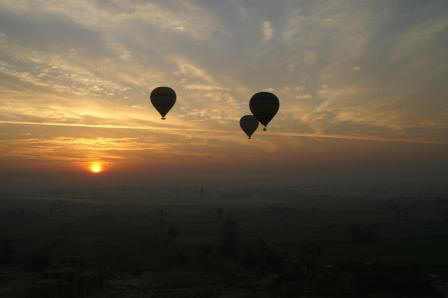
Balloons over the desert.
All we did this year was sleep on a ship moored at Luxor
on the Nile across from the Luxor Temple. We saw the sunrise from a balloon
this morning that hovered over the desert. What a sight it was to see the sun
rise over Luxor, the Nile River, and the Valley of the Kings!
The whole process of ballooning was interesting and highly labor-intensive, which
is easily accommodated here in Egypt.
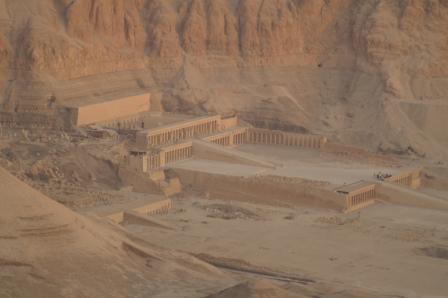
Queen Hatshepsut's Temple.
We took off from an unnamed set of Egyptian ruins, sailed
effortlessly over local villagers and their homes, then meandered over the
Valley of the Kings and Queen Hatshepsut's Temple.
Balloons are less like flying and more like floating. The
main issues are with liftoff and landing. We had a perfect morning, so we had
no problems with either, but balloons do land where they want to, so we did
end up landing in a new home construction area, closely followed by our army
of handlers.
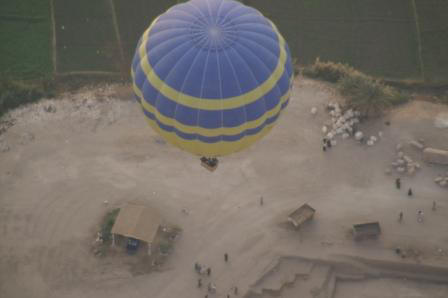
Here is a photo of another balloon making its landing.
After landing, we were taken to a hotel on the west bank
of the Nile. The west bank was considered by the ancient Egyptians as the
land of the dead since this is the side the sun sets on. We ate our meager
breakfast with a spectacular view of Luxor on the Nile. Then we headed back
to the east side of the Nile—you guessed it, the land of the living—to have
a rest, lunch, and prepare for our visit to Karnak Temple that afternoon.
The Nile is indeed a beautiful place, although it seems the favorite pastime
of the Egyptians is to throw rubbish in it.
We spent the afternoon at Karnak Temple, a huge site built by various
pharaohs over more than a 1000-year period.

The Nile.
It was then buried in sand for another 1000 years until
the 19th century when it was discovered. There is so much to see, including
strange marks on the rocks where Roman soldiers sharpened their swords, and
early Christian paintings of Mary and Jesus are carved on the ancient
pillars like graffiti. There's lots of evidence of ancient politics too.
Romans used to cut off the noses from many of the statues and hieroglyphics.
This was to destroy the pharaohs' system to gain an afterlife, as Egyptians
once believed that the soul needed to re-enter the body via the nose. I
guess as likely a body orifice as any!
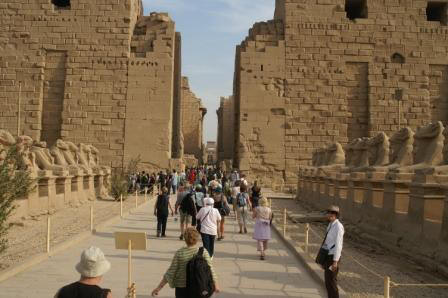
Karnak Temple.
There is a giant scarab beetle statue, a symbol
of good luck. Since it was New Year's Day, our guide told us that today things
were extra lucky. So we did the recommended ceremony, which was to walk
around three times while making a wish. Being there made us think about the
meaning of life, the universe, and everything; oh yes, that was 42.
Julia and I went for a walk in the local bazaar this
evening. The men manning the stalls are really hard-sell and would not let
us walk past without trying to get us to buy something. This got very
tiresome after a while, so we left to go to bed early again as we have another
early start tomorrow.
Wednesday, January 2, 2008
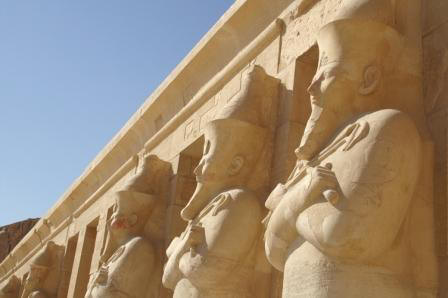
The Valley of the Kings.
The showers in Egypt, that we have encountered so far,
all have a common theme: they all leak water all over the bathroom floor.
This was true in the hovel back in Cairo and is the same with
the shower in our cabin on the ship, which we now refer to as the
floating hovel.
Once again, we rose early to be transported over the Nile
to the land of the dead. This time, once we were there, we were acquainted
with some donkeys, which were to be our transportation to the Valley of the
Kings. They gave us all a short instruction course on how to show the
donkeys that we were their masters. We were placed on their backs, and
immediately gave up control to the donkey, which in my mind is where it
rightfully belongs. An hour and a half later, after much stretching of our
groin muscles, we arrived at our destination.
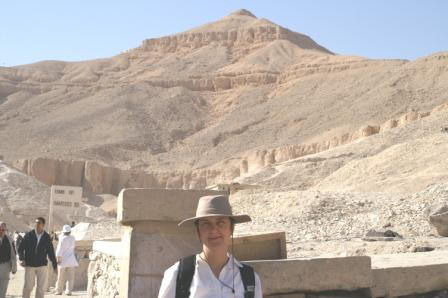
Here is a photo of Julia standing in front of the
Valley of the Kings. Notice the natural pyramid mountain behind her, which
is why they chose this site to be the kings' burial grounds.
The Valley of the Kings was constructed by the pharaohs
that came after the kings who built the pyramids at Giza. The reason they
stopped building pyramids and started digging holes was due to the
looting that always took place after a king was buried in a pyramid. Let's
face it: you can see the pyramids at Giza from a long way away.
The Valley of the Kings has 63 currently located tombs, and they are actively
looking for more.
We then headed to Queen Hatshepsut's Temple, which we had
seen from the balloon yesterday, this time via taxis as the donkeys were not
fast enough to meet our schedule. Queen Hatshepsut was the only known female
pharaoh. Once she was dead, her nephew took over and was so upset that she
had usurped the throne from the next rightful male pharaoh that he had all
of her images, well almost all, chiseled out of her monuments. We headed
back to our ship and the land of the living and set sail for Aswan.
Balloon Video
Mohammed Video
Donkey Video
Nile Video